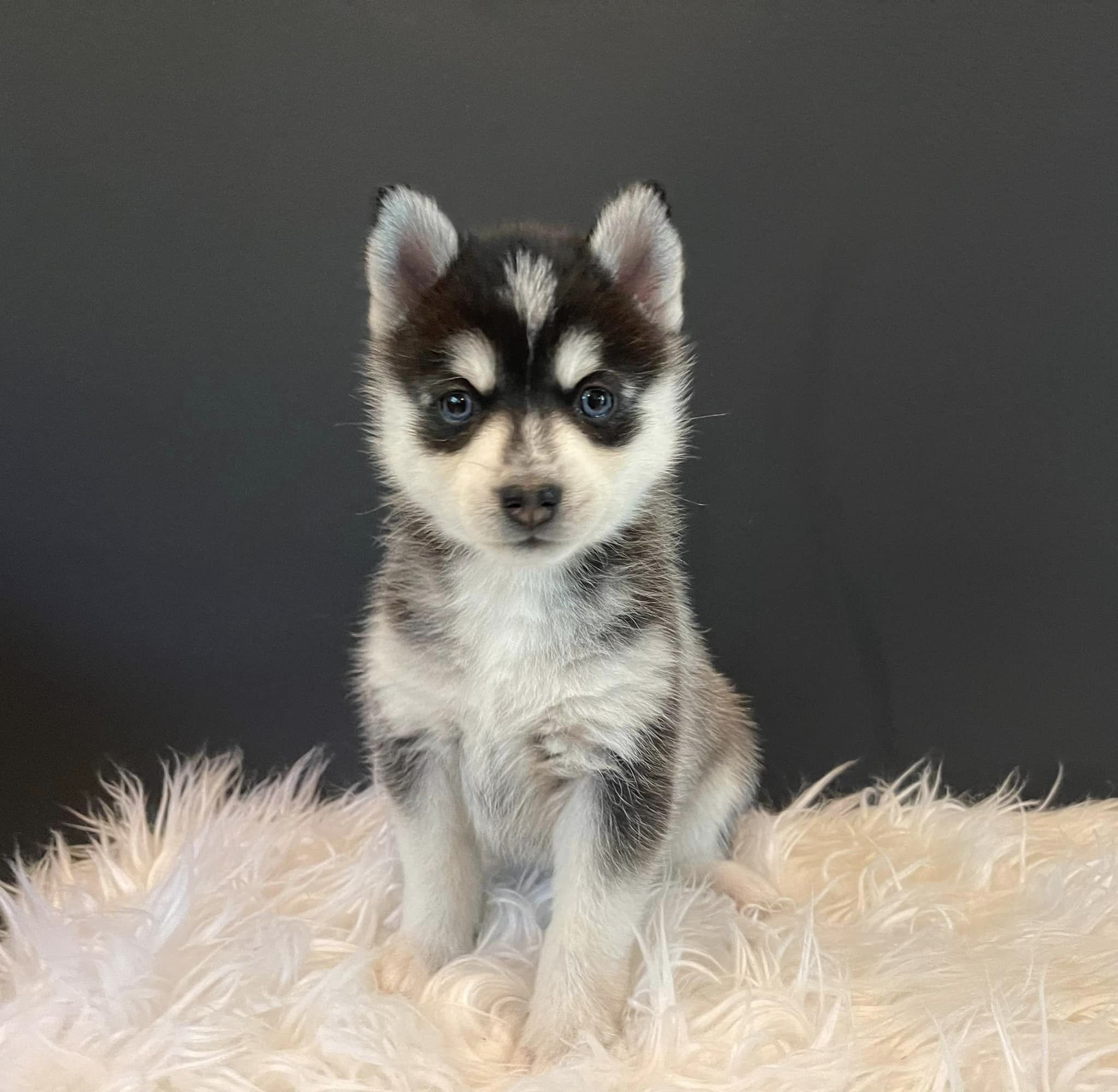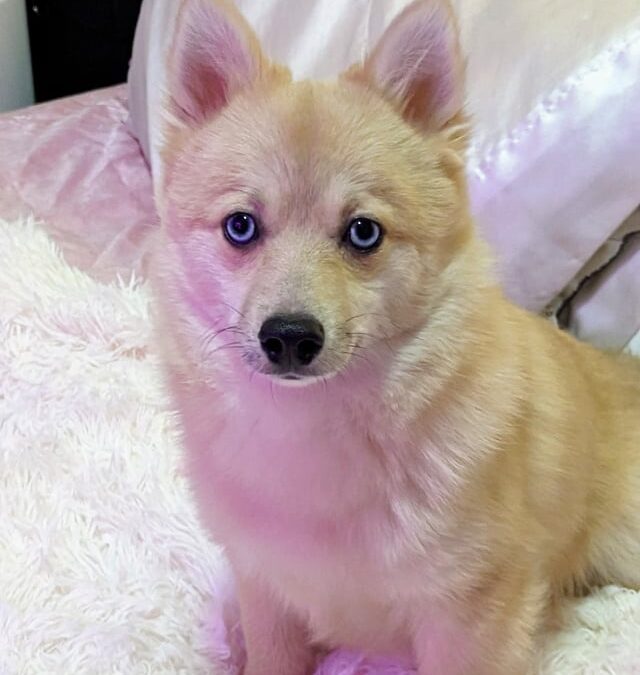Pomskies can be challenging for first-time owners due to their high energy and training needs. They require dedicated time and effort to manage their social and exercise demands.
As an energetic and intelligent crossbreed between Pomeranians and Siberian Huskies, Pomskies have captured the hearts of many with their adorable looks and playful nature. These dogs are known for their loyalty and affection, making them appealing companions. Nevertheless, potential pet parents should note their tendency towards stubbornness, which means consistent training is essential.
They thrive on attention and interaction, leading to a demand for regular mental and physical stimulation. Owners must be prepared to cater to their exercise requirements to prevent destructive behaviors that can stem from boredom. Hence, while Pomskies offer an enriching pet experience, they might pose challenges for those unfamiliar with dog ownership responsibilities.
Pomsky 101: The Basics
These charming canines are a crossbreed and have captured the hearts of many.
The Pomsky Breed
The Pomsky Breed
Pomskies emerge from a mix of Siberian Husky and Pomeranian breeds.
| Size | Weight | Fur Type | Lifespan |
|---|---|---|---|
| Small to Medium | 15-30 pounds | Fluffy and Varied | 13-15 years |
- Dynamic and striking appearance
- Energetic and affectionate nature
- Love for play and exercise
Typical Temperament
Typical Temperament
Pomskies inherit distinct traits from their purebred parents.
They display a blend of intelligence, playfulness, and stubbornness at times.
- Friendly with family and strangers alike
- Alert and can serve as a good watchdog
- May inherit the Husky’s vocal nature
Training and socialization are crucial from a young age.
This helps them become well-adjusted companions.

Credit: www.westbaypomsky.com
First-time Owner Challenges
Taking in a Pomsky as a first dog brings unique hurdles. Pomskies offer abundant joy and companionship, yet they require dedication and patience, especially from new owners. Navigating the road of raising a Pomsky presents several challenges worth considering.
Understanding Your Commitment
Pomskies blend Pomeranian and Husky traits, leading to a mix of temperaments and energy levels. Prospective owners must commit time and resources to their new furry friend. This includes routine vet care, exercise, and mental stimulation essential for their well-being. Assessing one’s lifestyle and resources is crucial before taking on this lovable but demanding breed.
- Daily exercise: At least an hour required
- Regular grooming: Due to their thick coats
- Healthcare costs: Including vaccinations and check-ups
- Quality nutrition: For optimal health and energy
Training And Socialization Needs
Pomskies are smart but can be stubborn. Early training and socialization shape a well-mannered dog. Start training your Pomsky early to instill obedience and good behavior. Socialization with other dogs and people reduces anxiety and aggression. Attend puppy classes for professional guidance.
| Training Aspect | Details |
|---|---|
| Obedience Training | Commands such as sit, stay, come |
| Socialization | Exposure to various environments, animals, and people |
| Housebreaking | Consistent schedule and positive reinforcement |
| Behavioral Training | Addressing issues like barking or chewing early on |
Pomsky Suitability For Novices
Thinking about bringing a Pomsky into your life? A Pomsky is a hybrid between a Pomeranian and a Siberian Husky. They’ve won hearts with their stunning looks and playful nature. Before deciding, it’s essential to know if a Pomsky is right for beginners. Let’s explore some key factors.
Size And Space Considerations
Pomskies are medium-sized dogs. They can range in size, but most end up between 20 to 30 pounds. This size is manageable for first-time owners. They fit well in various homes, from apartments to houses with yards. Still, they’re active dogs and need space to play. Proper space ensures a happy, healthy pup.
Grooming And Exercise Requirements
Grooming a Pomsky is a big task. They have thick, double coats and shed regularly. This means brushing a few times a week. It’s a commitment, but a routine helps. Pomskies also pack a lot of energy. They need daily exercise. A combination of walks, playtime, and mental stimulation keeps them fit. This includes:
- Long walks or jogs
- Play sessions with toys
- Training for mental engagement
Exercise is vital for their well-being.
Temperament Traits To Consider
Embarking on the journey of owning a dog is thrilling. Understanding a breed’s traits ensures a perfect match. Pomskies, a blend of Pomeranian and Husky, are popular. They charm many with their looks. But, do their temperaments fit first-time dog owners? Let’s dig into some key temperament traits of Pomskies.
Intelligence And Stubbornness
Pomskies boast a sharp intellect. This trait can be a double-edged sword. Their intelligence means they learn quickly. Simple commands and house training are a breeze. This smart nature demands mental stimulation. Without it, they may find mischief.
Along with smarts comes a stubborn streak. It sparks from their Husky lineage. Consistency is a best friend with Pomskies. Positive reinforcement and patience are vital. They’ll thrive on a routine sprinkled with variety. This keeps their cunning minds engaged while curbing their stubbornness.
Social Behavior With Children And Pets
Socializing them early is key. Proper introductions set the stage for lasting friendships. Pomskies can be playful and gentle. They do well with kids when socialized properly.
Interactive games foster a strong bond. They often do well with other pets. But supervision is crucial. They inherit prey drive from their Husky parent. Ensuring a harmonious mix is crucial, especially with smaller animals.
Health And Wellness
Are Pomskies suitable for first-time pet owners? This question often arises when admiring the adorable mix between the Pomeranian and the Siberian Husky, known as the Pomsky. Understanding the health and wellness needs of this unique breed is crucial. Let’s delve into this subject to ensure prospective owners are well-informed.
Common Health Issues
Pomskies are relatively healthy, but they do inherit potential health issues from their Pomeranian and Husky parents. Some common concerns include:
- Dental Problems: Like Pomeranians, Pomskies can suffer from dental issues. Regular cleanings are vital.
- Allergies: Skin allergies may occur. Look out for excessive itching or discomfort.
- Eye Disorders: Keep an eye out for cataracts and other eye conditions.
Long-term Care Needs
Committing to a Pomsky means planning for its long-term care. Here’s how owners can promote lasting health:
| Aspect | Care Strategy |
|---|---|
| Diet | Provide a balanced diet with essential nutrients. |
| Exercise | Ensure daily exercise to maintain a healthy weight and stimulate their mind. |
| Vet Visits | Schedule regular check-ups for preventive care. |
Grooming plays a big part too. Pomskies require regular brushing to keep their fur in tip-top shape. Do not forget love and attention, as it’s key to their emotional well-being.
Training Tips For New Owners
Pomskies, a mix between Siberian Huskies and Pomeranians, are known for their stunning looks and playful disposition. Ideal for new owners ready to embark on a training journey, these intelligent dogs respond well to the right techniques. In the following section, we’ll dive into key training tips every new owner should know to guide their Pomsky through a successful learning experience.
Positive Reinforcement Techniques
Training your Pomsky with kindness always yields the best results. Here’s how you can effectively use positive reinforcement:
- Reward Good Behavior: Offer treats, praise, or playtime whenever your Pomsky obeys a command.
- Be Consistent: Use the same commands and reward system each time to avoid confusion.
- Keep Sessions Short: Pomskies have short attention spans. Limit training to 10-15 minute intervals.
- Stay Patient: Mastery takes time. Celebrate small achievements to build confidence.
Avoiding Common Training Pitfalls
Avoid these common mistakes to prevent setbacks in your Pomsky’s training:
| Mistake | Consequence | Prevention Tips |
|---|---|---|
| Inconsistent Schedules | Poor Habit Formation | Set a regular routine for training sessions. |
| Negative Reinforcement | Fear or Aggression | Focus on rewarding good behavior instead of punishing bad. |
| Delaying Rewards | Slow Progress | Instantly reward to establish a clear association. |
| Lack of Patience | Loss of Trust | Remember that consistency and positivity take time. |
By following these training tips, you’ll help ensure that your Pomsky grows into a well-adjusted and obedient companion. Remember, consistency and positivity are your best tools in this rewarding journey.
Cost Of Ownership
Thinking about adopting a Pomsky? Understanding the cost is crucial. Pomskies are cute and endearing, but they come with their own set of financial responsibilities. Let’s delve into what you can expect in terms of the initial investment and ongoing expenses when welcoming this fluffy friend into your home.
Initial Costs
First impressions matter, and so does the first investment in your Pomsky. This cost often takes new owners by surprise. Here’s a breakdown:
- Purchase Price: Pomskies are designer dogs and can cost between $1,000 to $5,000.
- Vaccinations: Your new pup needs shots. Expect to pay around $75 to $100.
- Spay/Neuter Fees: This one-time expense can range from $200 to $500.
- Initial Supplies: Bowls, beds, and toys add up to approximately $100 to $500.
The total initial cost? It can be anywhere from $1,375 to $6,100.
Ongoing Expenses
After the first hello, your Pomsky will need continuous care and investment. Monthly and yearly costs include:
| Expense Category | Monthly Cost | Yearly Cost |
|---|---|---|
| Food | $40 – $60 | $480 – $720 |
| Grooming | $30 – $50 | $360 – $600 |
| Vet Visits | Varies | $200 – $700 |
| Pet Insurance | $20 – $50 | $240 – $600 |
Remember, unexpected costs can arise. Emergencies, medications, and additional supplies should also factor into your budget. Planning ahead secures a happy, healthy life for your furry companion.
Real Owner Experiences
Exploring the world of dog ownership begins with identifying the right breed for your lifestyle. The Pomsky, a mix between the Siberian Husky and Pomeranian, often captivates potential owners with its stunning looks and vibrant personality. But what’s the real deal with owning a Pomsky, especially for those stepping into dog ownership for the first time? Let’s delve into real owner experiences to shed light on this question.
Success Stories
Many Pomsky owners overflow with joy when sharing their stories. Their fluffy companions bring endless energy and laughter into their homes. They cherish moments like the Pomsky’s first howl and mastering tricks quickly, thanks to their high intelligence.
- Quick learners: Owners note that Pomskies excel in training sessions.
- Loyal friends: They form strong bonds with their families.
- Perfect size: Not too big or small, they fit various living situations.
Challenges Faced
Yet, owning a Pomsky does present unique challenges. Their pack mentality and prey drive call for consistent training and socialization. Their thick coats require regular grooming to avoid matting and maintain health.
| Challenge | Details |
|---|---|
| Exercise Needs | Pomskies need daily walks and play to burn energy. |
| Separation Anxiety | This breed can struggle when left alone too long. |
| Training Persistence | Consistency is key to overcoming stubborn streaks. |
Making The Decision
Making the right pet choice requires careful thought, especially for first-time owners. A Pomsky, a mix between a Pomeranian and a Husky, may be on your radar. This charming breed captivates with its striking looks and playful nature. But, are they the best fit for your life?
Assessing Your Lifestyle
Owning a Pomsky demands a specific lifestyle. Here’s what to consider:
- Space: Do you have room for a medium-sized dog to roam and play?
- Time: Pomskies need daily exercise. Can you provide this?
- Attention: They thrive on interaction. Are you often home?
- Grooming: Their coats require regular care. Will you manage?
Resources For Prospective Owners
Knowledge is key. Consider these resources:
| Resource Type | Description | Usefulness |
|---|---|---|
| Books | Comprehensive care guides | High |
| Online Forums | Community advice | Medium |
| Vet Consultations | Professional health tips | Essential |
| Local Breeder Meetups | First-hand owner experiences | High |
Explore, ask questions, and prepare. The right resources can ease your path to becoming a Pomsky owner.

Credit: www.reddit.com
Alternatives To Consider
Pomskies charm many with their fluffy coats and lively eyes, but they may not be ideal for everyone, especially first-time dog owners. Before committing to a Pomsky, it’s essential to consider other breeds and options that might be more suitable for beginners. Let’s look at some great alternatives.
Breeds For First-time Owners
Selecting the right breed is crucial for a first-time owner. You want a dog that is trainable, has a manageable energy level, and is known for a good temperament. Here’s a list of breeds often recommended for new owners:
- Golden Retriever: Friendly and patient.
- Labrador Retriever: Loyal and easy to train.
- Bichon Frise: Small and affable.
- Cavalier King Charles Spaniel: Affectionate and adaptable.
- Boxer: Fun-loving and loyal.
Adopting Older Dogs
Older dogs often come with less surprises. They’ve typically outgrown the hyper puppy stage and their personalities are well-formed. Plus, they can be just as loving and rewarding as a puppy. Consider these benefits of adopting an older dog:
| Benefit | Description |
|---|---|
| Training | Many older dogs are already house-trained. |
| Temperament | What you see is often what you get. |
| Exercise | They may require less than a younger dog. |
Adopting an older dog can often lead to a more relaxed introduction to dog ownership.
Frequently Asked Questions On Are Pomskies Good For First-Time Owners
Are Pomskies Good For Beginners?
Pomskies can be challenging for beginners due to their high energy and intelligence. They require consistent training and socialization, making them better suited for experienced dog owners.
Are Pomskies High Maintenance?
Yes, Pomskies are high maintenance due to their energy levels, grooming needs, and demand for attention and training.
What Are The Cons Of A Pomsky?
Pomskies can be expensive and may inherit health issues from their Pomeranian and Husky parents. These energetic dogs require a lot of exercise and can develop separation anxiety if left alone. Their thick coats also need regular grooming.
What Do I Need To Know Before Adopting A Pomsky?
Before adopting a Pomsky, know they need regular exercise, mental stimulation, and grooming. They can be stubborn, requiring consistent training. Research their health needs and potential size, as Pomskies can vary. Prepare for a long-term commitment, as they can live up to 15 years.
Conclusion
Navigating the world of pet ownership can be tricky, yet Pomskies stand out as a charming choice. These energetic, affectionate canines may require attention to training and exercise, but their size and temperament make them manageable for novices. As with any breed, education and preparation are key.
Prospective owners should research and consider lifestyle compatibility before welcoming a pomsky into their home, ensuring a loving, lasting bond.

